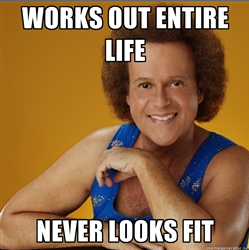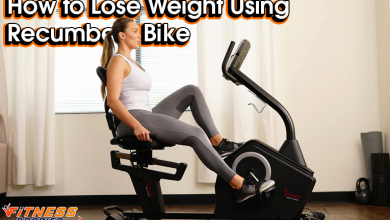The Cardio Default: A Rant
This is a rant.
I wrote this awhile ago before I moved to Toronto. Finding and rereading it, I found I felt the same way, especially now that I work mainly with general population clients – businessmen/women, busy moms, older clients, etc. Read it carefully before you get pissed off or tell me that “something is better than nothing”or accuse me of saying cardio is bad. The reason why some trainers want to jump on the cardio-hate bandwagon is simple; it’s the default anyone turns to for getting fit, and therein lies *our* frustration. This is NOT a scientific discussion of the pros and cons of cardiovascular exercise. Nor is it a discussion about the energy systems used in training.
This is a social discussion about the conditioned and perpetuated link between cardio and fitness.
The book Supertraining by Siff and Verkhoshansky says this about the history of what I am dubbing “the cardio default”:
“During the years after both World Wars, Russia and Europe still continued to promote the virtues of physical strength and power, whereas research in the West rapidly veered in the direction of cardiovascular fitness, assuming great impetus with the running for health and ‘aerobics’ craze (great childhood memories from those!), associated closely with Swedish endurance exercise research and popular fitness books such as Kenneth Cooper’s ‘Aerobics.’ This resulted in the vigorous promotion of the cardiovascular doctrine, the paradigm which maintains that cardiac and general health depends predominantly on prolonged endurance or ‘aerobic’ exercise. At the same time, proponents of this doctrine fairly vigorously denigrated the health benefits of strength training. … It was inevitable that the accompanying high profile marketing and media campaigns, extensively underwritten by the medical profession, would make the pursuit of strength oriented sports considerably less attractive in the public eye. … The West today would appear to have reaccepted a useful role for strength training, but the proliferation of weight training facilities and personal trainers still has much more to do with commercialism than the impact of strength science, as is emphasized by the fact that the cardiovascular doctrine still dominates the fitness conscious psyche.”
It still dominates.

Around here (St. Johnsbury Academy), it’s cardio room, cardio room, cardio room.
“Joy, why am I getting fatter when running is supposed to make me thin.”
“Joy, why do I feel so tired and weak, when I have been faithfully doing my cardio.”
“Joy, why do my knees keep hurting.”
“Joy, my coach wants me to be faster, so I am running more on the treadmill.”
I get these questions from kids all the time, and I get the same from adults who I program for. They are so worried about cardio. Won’t cardio give them the body of their dreams? Make them strong? Make them powerful? Make them jump higher? Melt that fat they’ve been holding onto for the last 10 years? They mention guiltily that, “Well I have tried to get in the cardio room, but it’s hard to find the time.”
I don’t get mad. In fact, I know exactly how they feel. I worked out for years, feeling trapped that if I missed a day of some form of cardio (and my “weight” training was usually cardioish), or didn’t cardio hard enough (boot camps) I would lose my gains. Literally. And I would. This was not just because of exercise, it was a combination of a lot of misinformation about “health” in general.
I usually try to explain to my kids/clients the “why” in a way they can relate to, so they can accept it and then understand why I want them to do something. And of course, I experience a lot of resistance. Why? Because the overwhelming information about fitness has to do with cardio-based exercise and cardio machines.
I have had a hard time pulling my teenage athletes away long enough to convince them they do not need treadmill time for their sport and in fact prefer they do their running outside (for healthy mechanics).
I have a hard time convincing the gymnastics girls that pounding away on the treadmill was NOT making their joints stronger or helping them do a pullup.
I have a hard time convincing the obese cheerleading coach that the reason half her girls ended up in braces and wraps was not just cause they were overweight (though that was part of it), and that no, lots of extra cardio was not what they needed in order to hoist each other up.
I have a hard time convincing the overweight football coach that most of his players needed to lift properly and regularly to not be injured halfway through the season and actually be able to sprint.
I have a very hard time explaining to the track and field coach that jogging did not train powerful hip extension for the shot putters and high jumpers.
You would think providing examples of what actual athletes do for S&C training and presenting the current S&C research would help (at least with coaches), but go figure. It didn’t.
Why? Cardio is all they know.
And for the Average Joe pop, there seems to be even less hope.
It’s the end of the two years here at the high school, and I’ve managed to shift the mindset in this weight-room. It’s packed. Kids come in for workouts consistently all the time. The most faithful attendees (the basketball team) had their best season yet (the only game they lost was the last one!). The tide is changing. I didn’t let any athlete “do something that was just better than nothing.” I chased them all. I have been relentless.
I am perfectly fine with someone doing what they can. Even if that does start with cardio machines. That’s how you start. By starting something! But then what?
I am not OK with people not being open to learn how to workout effectively long term and not get frustrated (and therein lies my responsibility to educate). I am not OK with making excuses or accepting compromises about the rampant misinformation surrounding the fitness industry.
Achieve your nutrition and training goals with Joy’s expertise and support.
Get started now And any trainer that does not speak out about it perpetuates it.
I don’t believe in ramming down someone’s throat an elitist list of “what you SHOULD be doing.” But as trainers, we need to be tireless in educating whenever possible. We need to encourage people to question, evaluate, and grow. You have to be uncomfortable with “better than nothing.” I cringe every time I hear that damn line.
If you prefer to compare yourself or your clients to nothing, than you deserve what “better than nothing” will get you for results.
I’ll give you an example from last week about recommending cardio. I had a complimentary session with a skinny-fat businessman named K (he’s now lifting happily with me). This guy needed help getting back into exercise. Rounded shoulders, thin soft arms, a little pooch. During our session, I outlined why I focus on strength and mobility first and sprinkle in some anaerobic conditioning. Since he does not have a lot of excess fat to lose and wants to build some muscle, I explained why he could get great results with heavy lifting and some diet changes. I told him he didn’t need to spend hours in the gym. When outlining why cardio would not give him the results he wanted, he mentioned that he enjoyed it as a stress-reducer. I said great! That was a good reason to engage in it! I just asked him to do it on non-lifting days and eat a bit more. Done! Imagine K on his own, thinking that his hour on the elliptical would get him muscles. As a beginner, he had no doubt would see some improvement. He didn’t know doing so would set him down the path of many disheartened gymgoers.
Add more cardio?
Eat less?
Sweat harder and harder?
Where are my muscles?
I don’t understand why my “work” isn’t working!
As a busy businessman who travels frequently, I could imagine the joy he would experience in reaching his health and physique goals by understanding what could get him there better and more efficiently.
I am taking on a new client who is an older businesswoman. She has been a serial dieter and exerciser for years. Now, she is borderline fanatical about losing some fat. She wants every session to be intense, and she thinks she has to work harder and harder. I have watched her for a couple of weeks. Laziness is not her problem. If anything, she is working too hard. Too few calories and long cardio sessions are the problem. How should I help her change her perspective and actually get results? I am working against 15+ years of misinformation that she will be very defensive about. That’s OK. The question is rhetorical.
What does a “better plan” or “better training” mean? What does doing BETTER-than-just-anything mean? “Better” does not mean perfection. It doesn’t mean you have to invest a lot MORE energy, work, and time, tracking this and that. It means that for the same or less effort than you are putting in now, you could get more from it in terms of results. “Better” means there is no reason for you to be confused by your results, or to not get the results you want.
Cardio is the overwhelming default when people think about that magic word: fitness!
We must fight the default.
A default is “click-whirr” thinking. Automatic. Without a willingness to evaluate your actions and your results, a dangerous mindset settles in.
I talk to a lot of people who are not anywhere near even mildly educated about working out, and what do they think they need to do first? Cardio. What do they think burns fat best? Cardio. What do the magazines and their doctors tell them to do? Cardio at least 30 minutes a day twice a week. What do they always respond when you suggest they consider a weight program and machine-free movement?
They say: “Well at least I am doing something.”
That is my only problem with cardio.
Most of my clients lack mobility and strength. Their joints are screwy. Their shoulders are rounded. Their muscles are lazy. Their hips are weak, their posture sucks, and their mechanics are all wonky. No surprise. They don’t damn move at all! But what do you think cardio (even group classes) and cardio machines do?
Encourage mindlessnes and shitty movement. Why? Not because of the exercise, but because of what is promised. Because marketing fast results and “just do this” is popular.
Please do a class if it will start you moving. Please do something. That’s not just OK – that’s great.

But since I like my clients getting results, I do like to steer them away from anything that encourages mindlessness and keep them very involved in changing their bodies – especially in the beginning.
I see the bigger picture. I want people to do what they like, what makes them happy, and what gives them what they need. This has less to do with “cardio” and more to do with education and integrity, BUT through this link cardio = fitness, we get a prime example of a conditioned connection that is hurting our industry. It’s time to change the paradigm.
So if someone asks me about how to change their body, I WILL direct them to weights, machine-free movement, and diet first. Not cardio in the modern-day definition. And I will give them a brief primer on the cause and effect of certain types of exercise. This takes me about five minutes and I do it with every client and in every presentation. Since cardio is overwhelmingly the default, I give them ample ammo to help them understand why a focus on strength training comes first; so they can do any kind of exercise they would like eventually pain/injury/frustration free.
And really it’s not the exercise. It’s the prevalence of two attitudes:
1.) Our resistance to change
2.) Our attraction to what is easier
Run the other way (pun!).
This is my problem with cardio.



